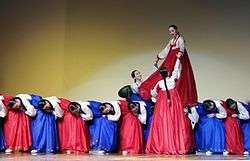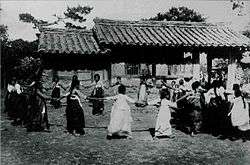Ganggangsullae
| Ganggangsullae | |
 | |
| Korean name | |
|---|---|
| Hangul | 강강술래 or 강강수월래 |
| Hanja | 姜降戌來 or 强羌水越來 |
| Revised Romanization | Ganggangsullae or Ganggangsuwollae |
| McCune–Reischauer | Kanggangsullae or Kanggangsuwŏllae |
Ganggangsullae (Hangul: 강강술래) is a 5,000-year-old Korean dance that was first used to bring about a bountiful harvest and has developed into a cultural symbol for Korea. It incorporates singing, dancing, and playing and is exclusively performed by women.[1] The dance is mostly performed in the southwestern coastal province of Jeollanam-do.[1][2] It is often associated with the Chuseok holiday and Daeboreum.[1]
History
The dance is thought to have originated around 5,000 years ago when the Koreans believed that the Sun, Moon, and Earth controlled the universe. Participants would dance under the brightest full moon of the year in order to bring about a good harvest.
In the 16th century, during the Japanese invasion of Korea, Admiral Yi Sun-sin ordered women to do this dance in military uniform to intimidate the Japanese. The women were said to have dressed in military uniform and danced on Mount Okmae (옥매산). The Japanese scouts thus overestimated the strength of the Korean troops.[3][4][5][6]
On February 15, 1966, ganggangsullae was designated as Important Intangible Cultural Properties of Korea #8.[2]
Characteristics

Traditionally, this dance is performed only by women at night without any instruments. Young and old women dance in a circle at night under the moonlight. They go outside in traditional Korean clothing, hold each other's hands, make a circle, and start rotating clockwise. The lead singer sings a line and everyone sings the refrain 'ganggangsullae'. The song tempo progressively becomes faster. They sing about their personal hardships, relationships, and desires. During the dance, the women play a variety of games. The dance can last until dawn.[6]
References
- 1 2 3 I-hwa Yi (2006). Korea's pastimes and customs: a social history. Homa & Sekey Books. pp. 79–92. ISBN 978-1-931907-38-5. Retrieved 25 July 2011.
- 1 2 "Ganggangsullae Dance". Archived from the original on 2011-06-13.
- ↑ "Ganggang Sullae, Thanksgiving Day Festival".
- ↑ "Ganggangsullae of Sopo". Archived from the original on 2009-06-09.
- ↑ "Ganggangsullae". Archived from the original on 2011-06-10.
- 1 2 Lee E-hwa (2006). Korea's pastimes and customs: A Social History. Ju-Hee Park (trans.). Homa & Sekey Books. pp. 170–172. ISBN 1-931907-38-2.
See also
External links
| Wikimedia Commons has media related to Ganggangsullae. |